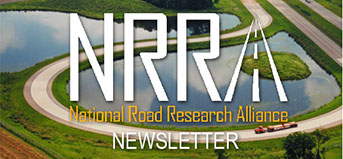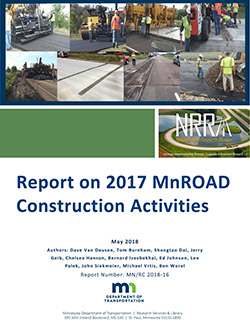NRRA Newsletter: June 2018

NRRA


If you haven’t read the 2017 Construction Report that summarizes all of the pavement experiments sponsored by the NRRA, here’s a quick summary of the highlights. We hope, of course, that you will dig deeper into the report to see how our teams constructed and implemented test cells that that will answer some of the most important pavement design questions we all face.
Here are the highlights of the report:
 within a day of construction. We pushed the envelope on that section by installing a large stone subbase over a surface that we created to be the worst conditions possible: clay, torn up by dozers and soaked with enough water to make it pure mud. The section that received 18 inches of large stone for the subbase is still performing well, but the section that only received 9 inches failed right away. John Siekmeier, principal engineer with MnDOT, quickly took the failed cell and turned it into 5 experiments with a combination of geogrids and geotextiles. It’s fine now. Before all of this, the subbase was the site of intelligent compaction research from our members at the University of Texas El Paso and automated plate load testing by Dave White and Ingios.
within a day of construction. We pushed the envelope on that section by installing a large stone subbase over a surface that we created to be the worst conditions possible: clay, torn up by dozers and soaked with enough water to make it pure mud. The section that received 18 inches of large stone for the subbase is still performing well, but the section that only received 9 inches failed right away. John Siekmeier, principal engineer with MnDOT, quickly took the failed cell and turned it into 5 experiments with a combination of geogrids and geotextiles. It’s fine now. Before all of this, the subbase was the site of intelligent compaction research from our members at the University of Texas El Paso and automated plate load testing by Dave White and Ingios.Along the way, traditional testing was supplemented by intelligent compaction technology, thermal imaging and the Rolling Density Meter (RDM). We are currently managing the data, says Van Deusen. “We have complimentary types of data with different advantages and disadvantages, and we are going to try to roll them all together and see how they compare,” he added.
At this year’s Pavement Workshop, we collected all of the PowerPoint decks and posted them to the website. In addition, we tried an experiment: we attempted to capture Skype recordings of all of the presentations. The Skype recordings are synced up audio and Powerpoint videos of the presentations we had at the Workshop this year. We hope you will share these presentations with peers and coworkers.
As we mentioned, this was an experiment so we didn’t capture all of the presentations. We successfully recorded 23 out of 30 presentations at this year’s Pavement Workshop.
Next month we will be hosting NRRA member Monte Niemi, president of First State Tire Recycling. He will be talking about Tire Derived Aggregates (TDA) and how they can be used in a variety of paving applications.
July 17, 10 a.m. (CDT)
Connection information
In an effort to investigate current and emerging technology in the paving industry, we have created a new team called the Intelligent Construction Technologies (ICT) Team. ICT includes innovative technologies for planning, design, construction, real-time quality control/monitoring, and management for the lifecycle of infrastructure construction.
The technologies this team will examine include:
The team leader will be Rebecca Embacher, Principal Engineer with MnDOT. Says Embacher, “We are very excited about this new team and the continued collaboration that it will allow between industry, academia and the governmental departments. The time and resources committed by this team will help fuel the development and deployment of various technologies that will assist us with the construction of longer, lasting pavements.”
In an effort to expand our alliance to more state DOTs, we have changed the pricing for some state agencies to $75,000 per year for those states who fall below a certain line in SRP funding. The following DOTs are eligible for the new pricing. If you know folks in these states, please spread the word about the NRRA.